Matt Cole of Fat Head’s in Cleveland is one of the most respected, award-winning brewmasters in the country. So, when he names his favorite beer from the state of Ohio, it’s wise to take note.
That beer is the Zwick’lbier Hoppy Pils from the Wooly Pig Farm Brewery in Fresno, Ohio.
“And if I close my eyes while drinking one in their beer garden, it feels like I’m back in a beer garden in Bavaria,” Cole says, including it in his Pick 6 for the Winter 2024 issue of Craft Beer & Brewing Magazine®. “Super-crisp, delicate, dangerously drinkable—the spicy floral hops with a very light perfumey note integrate so well with the malt.” Their Schwarzbier, he adds, may be a close second.
The farm on which Wooly Pig sits, in the Appalachian foothills, is more than 150 years old; there’s a big, red 19th-century barn in the backdrop of that beer garden. Cole says he also loves the pork steaks they sell there—and the wooly pigs from whence they come. The farm is currently home to a dozen Mangalica pigs, known for their shaggy appearance and fatty marbling. “The brewery would be as at home in Franconia or southern Bavaria as it is in the Ohio countryside,” Cole says.
That’s the sort of feeling that cofounders Kevin Ely and Jael Malenke hoped to evoke when the couple opened the brewery in December 2017. The beer quality is no fluke, either; Ely was brewmaster at Salt Lake City’s Uinta, where he oversaw production on as many as 80,000 barrels a year. (At Wooly Pig, he brews about 0.7 percent of that.)
Fresno, Ohio, incidentally, isn’t a town. It’s a “census-designated place” with a population of 46 people. The nearest settlement is West Lafayette—also not a town, but a village of 2,400 people.
Despite its location—about 85 miles east of Columbus and 100 miles south of Cleveland or west of Pittsburgh—Wooly Pig is profitable, Ely says, because they keep it simple. Besides being family-run and selling all beer on-site, there are a multitude of measures aimed at efficiency and sustainability—for example, the pigs get all the spent grain (and at least a little bit of beer).
Years of education and experience helped Ely shape a clear vision for the brewery as well as the life he’d prefer to lead. The concept is simple: “Fundamentally, we’re brewing beer that we want, that we enjoy drinking. You know, we also enjoy brewing it.”
At Wooly Pig, he says, “There’s a beer for pretty much anyone. But it’s going to be a lager.”
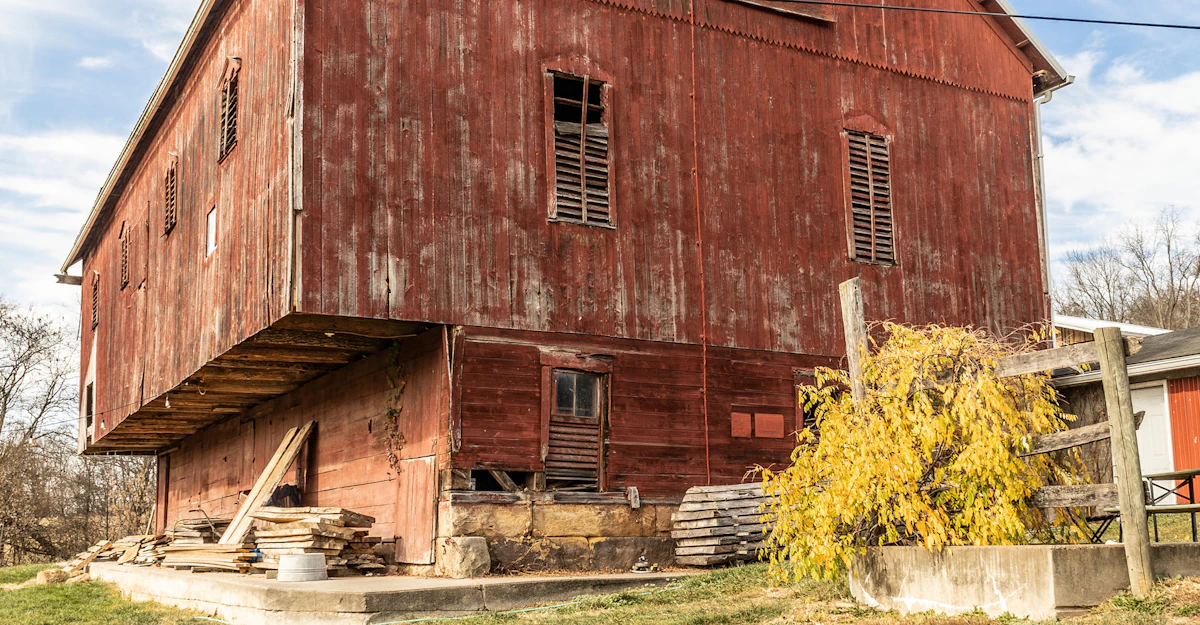
Following the Current
A high-school wrestler who became interested in nutrition, Ely went to the University of California, Davis, to study nutritional biochemistry. Just as his textbooks started getting into fermentation, he started getting into homebrewing. He also started looking closer at the UC Davis course catalog.
That’s how he ended up in brewing-science courses taught by Michael J. Lewis, as well as any other brewing-adjacent course the school would let an undergrad take in the late 1990s. “Food engineering and food processing, plant sanitation and industrial microbiology—just anything I could,” Ely says.
Aiming for an apprenticeship after his junior year, he mailed out 111 resumes to breweries in western states—all of them near decent whitewater rafting and kayaking. “That was probably my main love in college, and I would travel all over the West doing that,” he says.
Only 10 percent of those breweries responded, he says; only “one and a half” were interested. One of those was Ska in Durango, Colorado. Ely drove there from Davis on his spring break. “It was a horrifying drive, going over those mountain passes in March,” but he made it to the interview, and he left with a summer apprenticeship. It was unpaid, but his schedule was flexible; he earned money as a raft guide on the Animas River.
At Ska, he says, “I didn’t have any responsibilities. I’m just kind of hanging around, helping fill kegs and throw hops in the boil, and I’m just kind of watching things. ... So, I would leave and push rubber down the river through town for an hour or two, then come back and just hang out at the brewery.
“And then I crashed my truck.”
Ely had been living out of that truck. “I had to move into the brewery,” he says. Ska cofounders Dave Thibodeau, Bill Graham, and Matt Vincent let Ely crash on the office couch, “so that’s basically what I did for most of the summer.”
He went back to UC Davis and finished his degree, then spent a year guiding rafts and building stairs in the Bay Area. When a girlfriend moved to Salt Lake City, he applied for brewing jobs there—and got one, working at two brewpubs, Hoppers and Ruby River, both then owned by Sizzling Platter.
That girlfriend didn’t stick, but he soon met Malenke, who was earning her doctorate in biology at the University of Utah. About 10 days later, however, Ely accepted a job back in the Bay Area, at Pyramid’s former production brewery in Berkeley. “You know, a 10-day-old relationship, you really don’t have a lot of stock in that,” he says.
That would change. “You know, it was important,” he says. He was back in Salt Lake City less than a year later, close to Malenke and brewing at Uinta.
However, Ely wasn’t done shuffling around. Sizzling Platter soon hired him back to run production at their two brewpubs. “It was small operations, but I could set my own schedule,” he says. “It allowed me to ski a lot.” This time he stayed with them for four years—but Uinta kept asking if he would come back. “Every year they kept offering me more, but I kept getting big raises.”
Uinta, growing rapidly, finally lured him back. When he’d left in 2003, they were brewing about 15,000 barrels a year. Four years later, they were brewing 35,000—and, suddenly, Ely had to learn a lot about packaging. “We had one part-time maintenance guy who worked about seven hours a week,” he says. “I had to let him go because he mostly just drank beer. So, I took over basically all the maintenance at that time, which was crazy.” He knew next to nothing about the machines, but he got his hands dirty and learned quickly. “I ended up doing very well with that.”
He wore a multitude of hats—production, maintenance, quality assurance. “It was, I would say, highly stressful for nine years,” he says. “But I did learn a lot.” That learning continued as the brewery grew, expanded, and expanded more.
In 2012, Uinta cracked the Brewers Association list of top 50 breweries by volume. By 2014—when a private equity firm bought into it—Uinta was No. 38 on that list, producing 77,000 barrels a year and distributing to more than 30 states. “We were just going gangbusters,” Ely says.
He was initially excited about the private equity buy-in, but it didn’t take that long for the enthusiasm to wane.
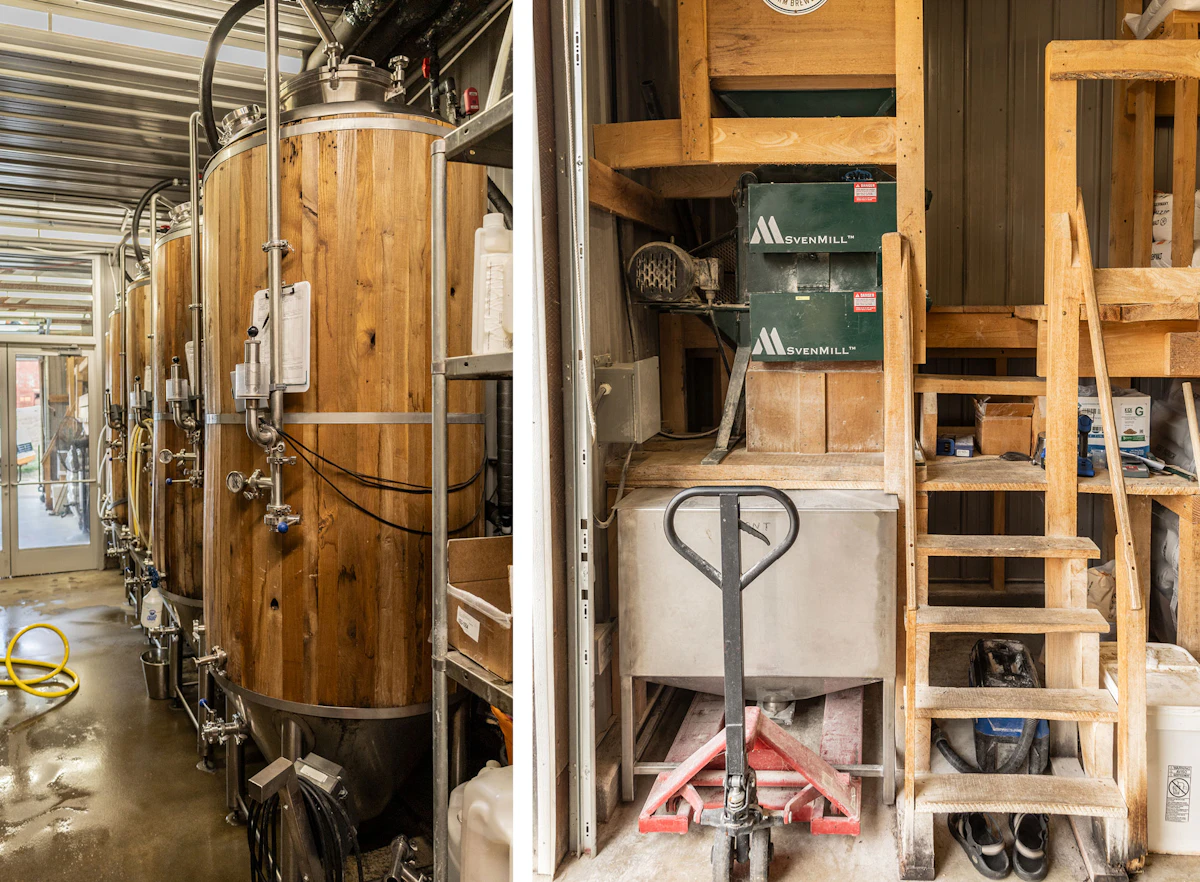
A Farm and Its Mascots
Wooly Pig and its farm are just one property away from where Malenke grew up, and her parents are still there—these days, they help out at the brewery.
“We would come here and visit, and I always enjoyed it,” Ely says. “And we had this opportunity to buy this farm, which [belonged to] a family friend of my wife’s parents. And I’d met the farmer here once—we’d come by to sing Christmas carols to him.”
Why the wooly pigs? That story goes back to Europe—but not to Hungary, home of the Mangalica breed. While Uinta was bursting at the seams, Ely made several trips to Germany to visit equipment manufacturers or attend BrauBeviale in Nuremburg. “I would always try to weasel away and do a bike ride around—north of Nuremberg, in the Bamberg region.”
On one of those trips, Ely and Uinta cofounder Will Hamill were cycling around the brewery-dense area known as Franconian Switzerland. “And I remember, on that ride, I saw these pigs,” Ely says. “And this was like mid-November, and it was a sow and … some piglets. And the piglets were tiny, and they had stripes and polka dots, kind of like markings you would see on a wild baby deer. And I just took some pictures, and then we continued on our journey from brewery to brewery.”
That fond memory and that vibe—leisurely visiting small, family-run breweries in rural Franconia—are what Ely and Malenke sought to re-create in Ohio. They bought the farm in 2014, along with Malenke’s brother Aaron and his wife Lauren, a veterinarian; they also live on the farm, work at the brewery, and raise sheep.
When they bought the farm, Ely says, “we didn’t have a plan to move here for like 10 or 15 years. I was like, ‘I’m not sure how this is going to work out. Maybe it’s just an investment and we come visit, I don’t know.’” The changes at Uinta accelerated a plan that had been on slow simmer in the back of their minds; he left the brewery and moved to Ohio with Malenke in March 2016.
In Coshocton County, Ohio, word began to spread quickly among its 36,000-ish people—many known to the family, including builders, bankers, and local officials. “It was so amazing just to walk into this community and be so well received, and have so much support on so many levels, and to have so much support from the family. I can’t state that enough.”
Their experience may have been, let’s say, somewhat different from what others face starting up in urban areas. Ely says he spent two weeks writing a business plan and showed it to the local small-business development advisor. “He was like, ‘I love this! Best plan I’ve ever seen! … Let me sit, let me call some bankers.’ And then we met some bankers. And we all—everyone gets all excited. And, finally, I picked what I thought was the smallest, closest bank that could support what we were doing.”
They got the funding in October 2016 and started building in earnest. “It was a busy time, too, to get equipment made and fabricated in that era,” he says. “Everyone was making brewing equipment—just making it as fast as they could, and they had at least one-year lead times on stuff. So, that allowed us to do a lot of the work ourselves.” All the maintenance and machinery experience from the Uinta years, and knowledge absorbed from brewing engineers in Germany and elsewhere, became invaluable.
Ely did a lot of the electrical and plumbing work himself. Malenke’s father and brother did a lot of the carpentry for the taproom, using wood from the farm’s disused sheds. The pigs, meanwhile, were eating, breeding, and preparing to contribute in their own ways.
Wooly Pig opened in December 2017—unbeknownst to most of the world, but amid much fanfare in Coshocton County.
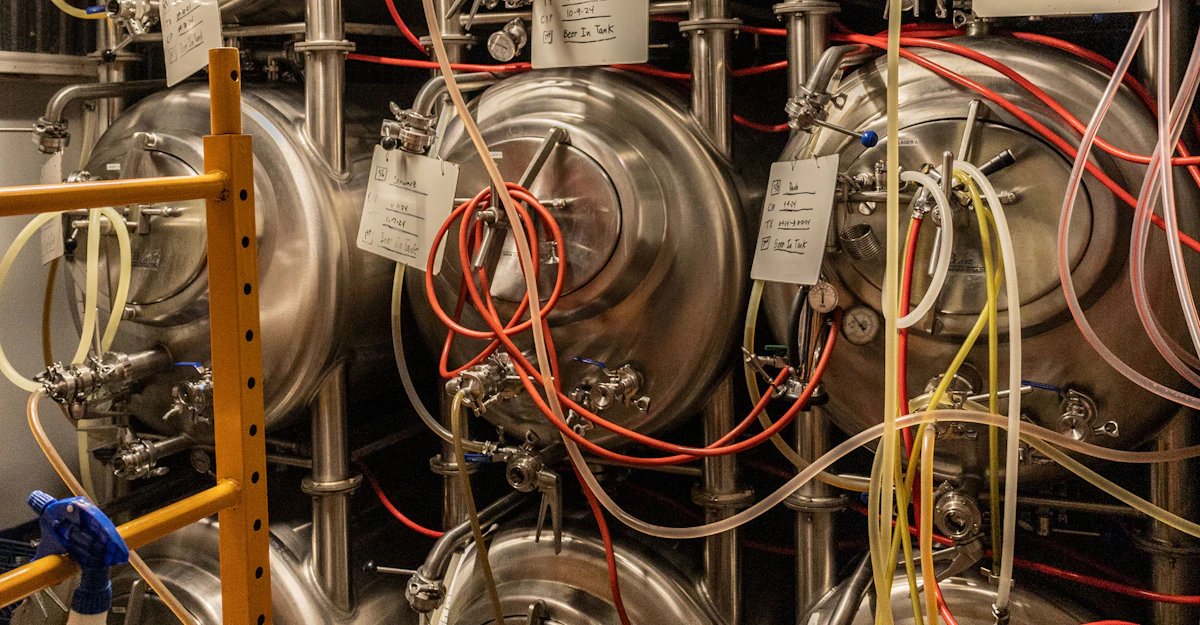
Efficiency and Swine
Wooly Pig is big on sustainability, “but not just for sustainability’s sake,” Ely says. “Sustainability, I think, is something that just works inherently, as a money-saver. … When you’re just trying to live efficiently and wisely, I would say, sustainability just happens.”
Spent grain goes to the pigs—who love it—so there’s no need to call a farmer to pick it up in their big truck. (“We carry a lot of buckets,” Ely says.) There’s more: Last runnings from the mash, green beer after a transfer, hop trub, scrapings from the tanks, even the taproom drip trays—connected to buckets via a manifold—it all goes to the hogs. “We send basically nothing down the drain,” Ely says. “We side-stream everything.”
They’re also installing a 100-kilowatt solar array at Wooly Pig—but Ely, who was involved with a large solar installation at Uinta, shares advice for those ready to splurge on solar up front: There are cheaper, easier ways to save money on energy.
Much of that comes down to efficiency of equipment and process. On Wooly Pig’s scale, it includes features as simple as a fan and a heat exchanger between the brewhouse and the taproom, channeling some of the heat into the taproom instead of allowing it to dissipate. “That cost me like $300, and I did all the plumbing myself in like three hours,” Ely says. The brewhouse and cellar are separate, with the fermentors near the two cold rooms, instead of burning extra energy to help keep tanks cool.
He’s also developed low-cost methods to minimize water and chemical use for CIP, often recovering and reusing it—and he delivered a presentation to the Ohio Craft Brewers Association on how to do it.
“Before you can do solar, you should have to do the basics first,” he says. “There are so many things you can do that are pretty easy that can save tons of energy.”
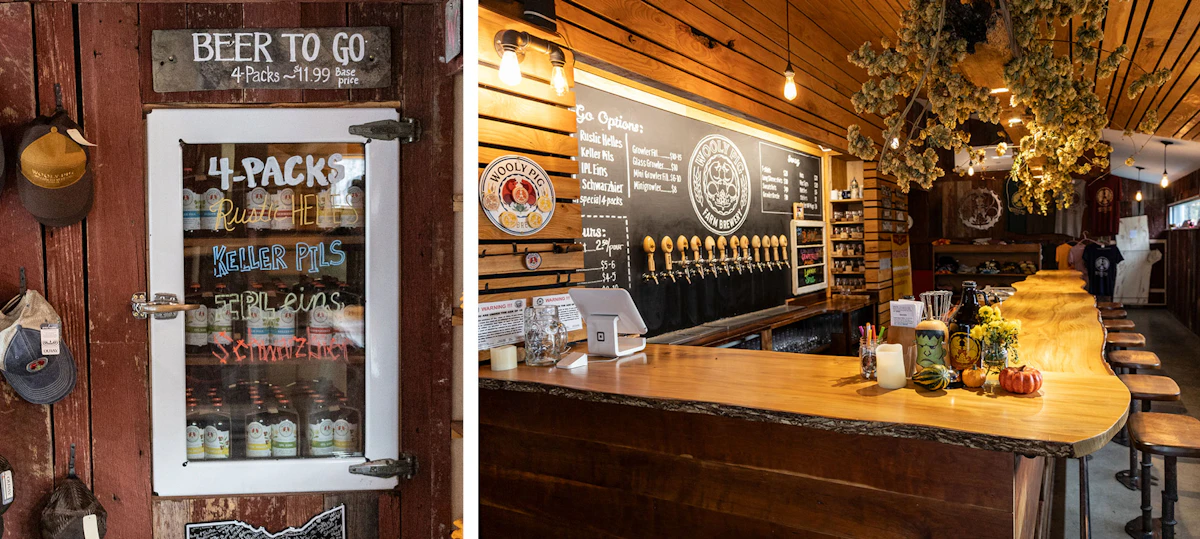
Lager for the Locals
Ely says roughly half of Wooly Pig’s customers are local—from Coshocton County or its immediate surroundings. The rest include people from surrounding counties as well as thirsty travelers trekking between cities.
Regular beers include Rustic Helles, the Zwick’lbier Hoppy Pils that Cole loves, Schwarzbier, and Rye Dunkel, as well as Fruited Gose and a hoppier one, IPL Eins. The range has accessible options for those accustomed to lighter beers as well as more flavorful ones for those who enjoy variety—but customers have surprised them from the start.
“We opened up, and I wasn’t sure what was going to happen,” Ely says. “My first batches were all ready. That first month, everyone that walked in was like, ‘Hey I drink Busch Light or Bud Light. What do you recommend?’ … Almost immediately, we sold out of helles, and then shortly after we sold out of pilsner. So, there was like a week there where I only had darkish beers.”
For those who wanted something lighter, they started recommending the Schwarzbier, at 4.4 percent ABV. “Lighter finishing gravity, and I try to brew it to be very drinkable,” Ely says. “Flavorful, but not overly so. … No astringency, no real roastiness, enough hops to keep it balanced, a touch of smokiness. No caramel or cloying sweetness or anything.”
Before long, they saw local farmers, among others, coming in to order full liters of Schwarzbier. “That became the thing,” Ely says. “And Schwarzbier, over the whole course of time for us, has been either a No. 2 or No. 3 best-selling beer—which is kind of cool because I think that speaks well to the style and that it’s what a lot of people want.”
Ely doesn’t expect production to tick upward much beyond 600 barrels anytime soon, though he could go as high as 900 “without really having to change a lot of stuff.”
He’d prefer to keep sales on-site only, for two reasons. “One is, it’s really simple and easy, and I’ve got complete control,” he says. “I’ve got no concerns about how things are being handled or treated or stored or managed.”
The other reason: Selling through distribution is challenging, requiring major changes to operation and mindset. “If you’re going to get in that game, you want to really get into it,” he says. “We could be very selective in our distribution, but it’s hard. I mean, even if we’re selective, you’ve got to get the beer there, and you’ve got to get the kegs back and stuff.”
Wooly Pig packages about 20 percent of its beer in stubby, grenade-style half-liter bottles with custom crowns and cartons. “And it’s nice that our bottles are only sold on site,” he says. “We sell 30,000 half-liter bottles a year in the form of a four-pack. We’ve got a little, old-school 1930s latch door that’s right next to the point of sale that opens up into our cold room. So, all of our bottled beers, we just kind of feed that into the hole, and that’s where we sell all of our bottled beer.”
While Wooly Pig is relatively remote, there’s a perk of being a destination: merch sales. The name, the pigs, the journey, and the art—they worked with an accomplished local designer early on—have helped them to sell things besides beer and pork. “You know, since we’ve opened, almost 20 percent of our total dollar sales has been merchandise, which is crazy,” Ely says. “I think it’s finally starting to slow down a little bit these last six months, but you can never really tell.”
The team is small—about 12 in total, virtually all family and friends, with only three working for the brewery full-time. “We all live pretty simply,” Ely says. “We don’t have huge salary requirements.”
In fact, he adds: “We keep everything really simple. It’s fundamental to how we operate, across the board.”
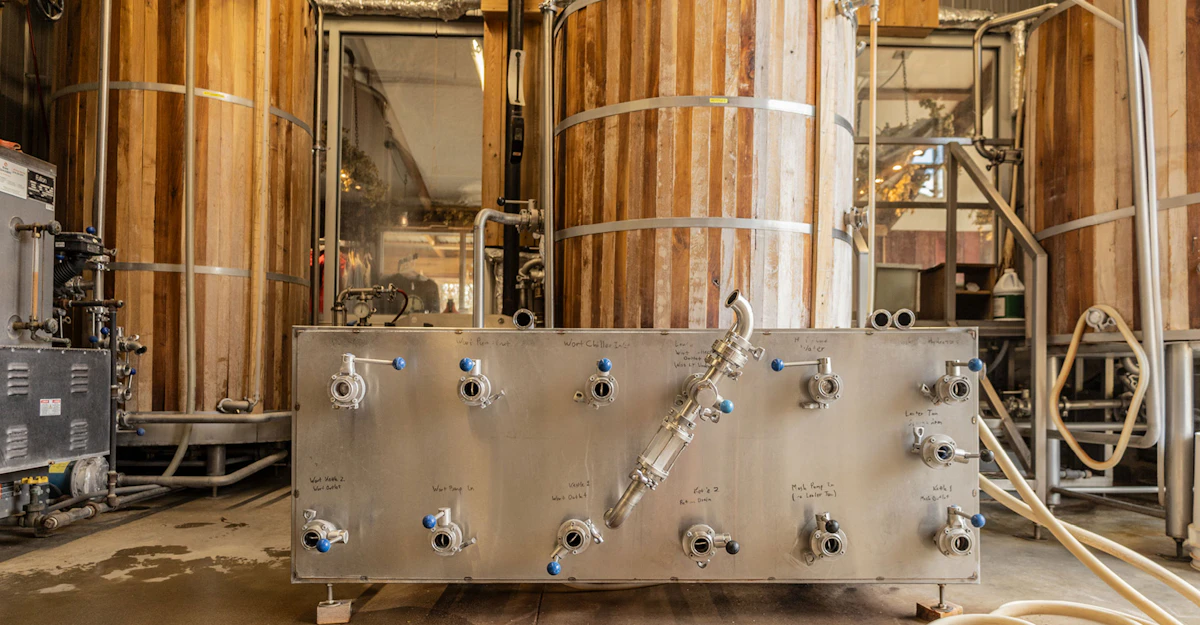
Gentle and Efficient
Wooly Pig’s brewing system includes three vessels that cofounder Kevin Ely designed to work, essentially, like four. There are two five-barrel kettles and a dedicated lauter tun, but the kettles also work as mash tuns. “I basically have everything set up so I can move anything wherever I want, whenever I want,” he says.
After a multistep Hochkurz mash, Ely transfers to the lauter tun, lautering into the second kettle. “Then, two hours after I’ve mashed in the first beer, I mash in the second beer,” he says. “So, I can mash in every two hours, just as you would in a four- or five-vessel larger brewhouse.”
With those consecutive batches, he can fill his 10-barrel fermentors, but he rarely needs to brew more than twice a week. However, he designed the system so that he could pull double shifts with relative ease, if needed. “I could actually do 3,000 or 4,000 barrels [a year] on that system,” he says. “It would be hilarious, but it would do it.”
Ely prizes “gentleness” in his system. That includes the mill—four rollers, about 11 inches in diameter and four inches wide. “This is a mill that could support a brewery 30 times my size, probably. It’s basically a modified feed mill.” The rollers’ large diameter hits the malt at a different angle than smaller ones, leading to a gentler crush. “I can get a really nice, light crack on the first roller, and then the second roller, I can crack a little bit more. I can have a husk that’s relatively intact. I can have grits that are fairly consistent in size.”
The malt goes into a grist case, but then—a luxury of smaller scale—there’s no need to send it through an auger or other conveyance that can damage the grains. “I just pallet jack it over next to my kettles, and I’ve got a hoist,” he says. “So, I hoist it up, and then it’s on a trolley, and it rolls, and it sits between my two kettles, so I can mash into either kettle.”
The gentleness continues into the brew. When transferring mash, flexible impeller pumps minimize shear. During the boil, the agitators stir slowly, working in conjunction with the steam-jacketed kettles for a quick, efficient boil. “I do a lot to try to minimize the thermal stress on my worts,” Ely says. “And then after the boil, what’s kind of cool, too, is I’ve got the agitator running. Then all I do is speed it up just a little bit, for like 30 seconds after the boil. And that’s my whirlpool. So, then it’s done.”
Ely says he tends to leave his beers in the fermentors for about two weeks before transferring to any of a dozen lagering tanks. He may lager for as long as seven weeks, but it’s usually closer to three. Occasionally he’ll transfer to another tank first, but often he connects straight to the taps when ready—the lagering tanks are also serving tanks.
“It’s a true zwickelbier or kellerbier because you’re just drinking it unfiltered, right off the lagering tank from the faucet.” It may pour slightly hazy at first, dropping brighter in the coming days and weeks. “There’s a little bit of evolution and flavor change in that,” he says. “It seems to work well, and we all enjoy it.”
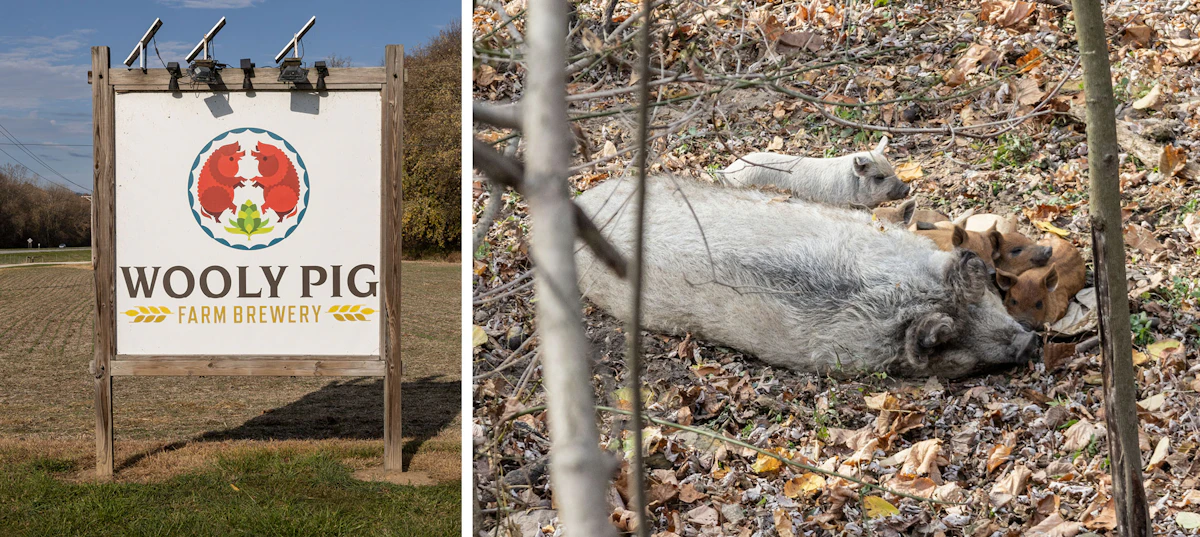
About the Pigs
The “wooly pigs” at the Wooly Pig Farm Brewery are mangalica, a Hungarian breed. They grow a thick, curly coat of hair.
As of mid-November, there were a dozen wooly pigs at Wooly Pig, including a recent litter of piglets. There have been many as 50, but these are pasture-raised swine, and this is not an industrial farming operation; they forage their 10 acres and eat brewery waste. To keep that manageable, Ely says, they like to stay between 15 and 25 swine. To avoid surprises, they keep the boar separate from the sows.
They occasionally process a hog for meat, and the local butchers get a kick out of it. “They’re always like, ‘The livers on these animals are the cleanest pig livers we’ve ever seen in our lives.’ And our theory on that is, because we’re always mixing the hop trub in with the feed, maybe there’s some antimicrobial capacity with the hops.”
They sell some pork at the brewery—such as the pork chops that go for $10 a pound—but it’s more quirk than revenue-driver.
“We don’t advertise the meat a whole bunch,” Ely says. “If we have more than we want, we just let people know that we have it for sale. … The pigs are there for us to be able to operate the brewery relatively easily on the farm,” he says. Plus, “they look super cool, and they’re fun.”
